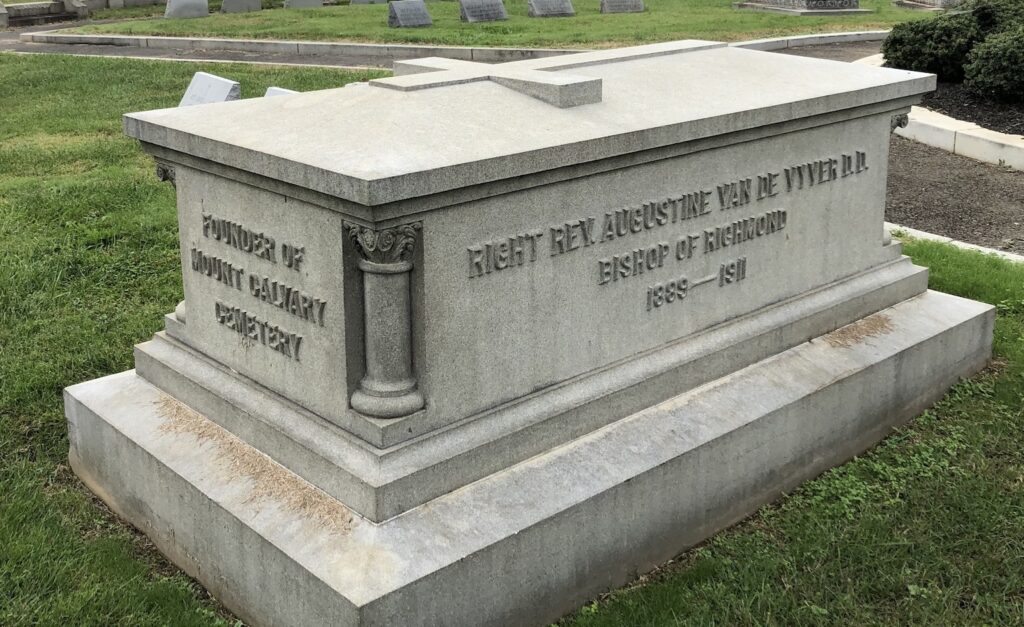BISHOP JOHN J. KEANE
A FITTING RESTING PLACE
The Cathedral of the Sacred Heart (1906), which includes a crypt for the entombment of bishops, was dedicated during the tenure of Augustine van de Vyver, the sixth bishop of Richmond (1889–1911). Yet, at his request, Bishop Van de Vyver was laid to rest at nearby Mount Calvary Cemetery. As vicar general of the Diocese of Richmond, he had bought the land for that cemetery in 1885.
There were two Catholic cemeteries in Richmond at the time land was purchased for a new one. One cemetery was operated by St. Mary Parish for German Catholics (1874). It was considered the burial place for German Catholics only, until it was formally opened to all Catholics and was renamed Holy Cross Cemetery (1924).
The other cemetery was known as the Bishop’s Cemetery, probably because the bishops of the diocese owned it, although none were buried in it. Funerary monuments indicate burials there as early as 1850 or 1857. Most of the bodies were transferred to Mount Calvary, and later the Bishop’s Cemetery became St. Joseph’s Cemetery, a burial ground for African American Catholics.
Mount Calvary Cemetery was named after the site of Jesus’ crucifixion: in Latin, Calvaria, meaning “Skull” (see Mt 27:33; Mk 15:22; Lk 23:33; Jn 19:17). Calvary designated a rocky mound shaped like a skull in an abandoned quarry on the outskirts of Jerusalem, with a tomb close by (see Jn 19:41).
In Richmond, Mount Calvary sits on a bluff overlooking the James River, and serves as the resting place for nearly 30,000 souls. Among the dead are 85 priests of the Diocese of Richmond and two bishops: Augustine van de Vyver and his successor, Denis J. O’Connell, the seventh bishop of Richmond (1912–1926).
John J. Keane, the fifth bishop of Richmond (1878–1888), who was Van de Vyver’s predecessor, recorded the blessing of Mount Calvary Cemetery in his diary. The entry appears under the general heading of Nov. 2, 1887, although it is unclear whether the rite was performed on that date or earlier.
In a pastorally sensitive action, Bishop Keane blessed only the section of Mount Calvary set aside for priests and religious (monks, friars, nuns and sisters), so that non-Catholic spouses and relatives could be buried elsewhere in the cemetery. (In 1859, the Vatican allowed bishops to grant permission for baptized non-Catholics to be buried in a blessed family mausoleum, although it discouraged this practice.) More recently, it has been customary for a priest to bless all of Mount Calvary Cemetery each year on All Souls’ Day, Nov. 2.
From the diary of Bishop John J. Keane:
+ 1887 Nov. 2nd.
Transfer of deceased Priests
This day, after solemn High Mass of requiem for our dead, [we] translated to our new cemetery, with a grand funeral cortege of an immense multitude of our people, the mortal remains of the four priests whose bodies have rested in the old cemetery, as named on p. 20 of this Record [Rev. Robert Andrews, Rev. Patrick Donetan, Rev. Chislain James Boheme, and Rev. James Hewitt].
Dec’d Sisters.
We transferred also the six Sisters of Charity & one Little Sister of the Poor who lay in the old cemetery.
Cemetery not Consecrated.
I have blessed only that part of the new cemetery set apart for the clergy & religious. The rest of the cemetery remains not blessed; and no part has been consecrated according to the form in the Pontifical, (the form in the ritual for blessing of cemeteries by priests delegated for that purpose having been used in blessing the portion above named.) This is because the conviction seems to be everywhere gaining ground that it is better to leave our cemeteries not blessed, in order that Protestant members of Catholic families may be admitted, & thus the whole family be held close to the Church, instead of having the Catholic members of a family to go to a profane cemetery, because the Protestant father or mother must go there, & this with considerable alienation of the whole family from the Church. — The question is left open, and should the contrary view prevail, the cemetery can be consecrated at any time. +

